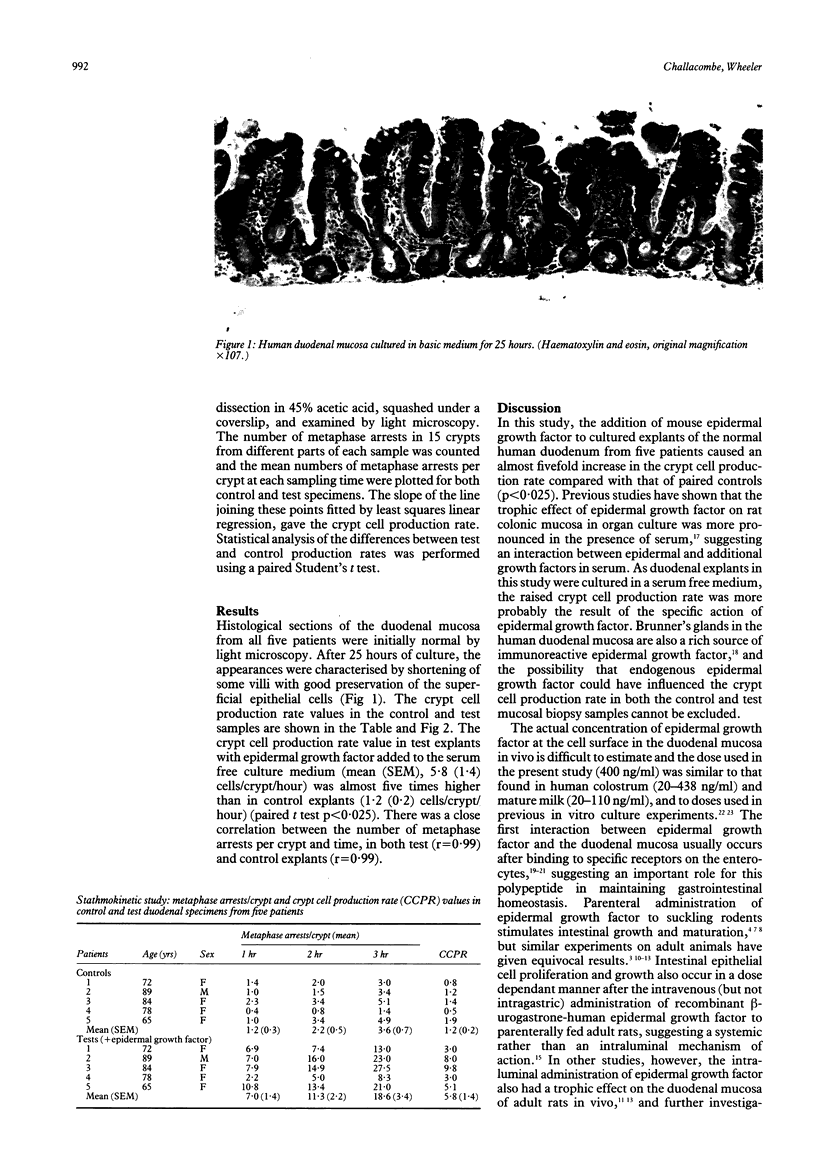Abstract
The action of epidermal growth factor on the human duodenal mucosa has been studied by estimating the crypt cell production rate in cultured explants, using a stathmokinetic technique with crypt microdissection. The addition of epidermal growth factor (400 ng/ml) to paired explants from five patients caused an almost fivefold increase in the crypt cell production rate, showing that epidermal growth factor has a trophic action on the human duodenal mucosa in vitro.
Full text
PDF


Images in this article
Selected References
These references are in PubMed. This may not be the complete list of references from this article.
- Bower J. M., Camble R., Gregory H., Gerring E. L., Willshire I. R. The inhibition of gastric acid secretion by epidermal growth factor. Experientia. 1975 Jul 15;31(7):825–826. doi: 10.1007/BF01938488. [DOI] [PubMed] [Google Scholar]
- Calvert R., Beaulieu J. F., Ménard D. Epidermal growth factor (EGF) accelerates the maturation of fetal mouse intestinal mucosa in utero. Experientia. 1982 Sep 15;38(9):1096–1097. doi: 10.1007/BF01955387. [DOI] [PubMed] [Google Scholar]
- Chabot J. G., Payet N., Hugon J. S. Effects of epidermal growth factor (EGF) on adult mouse small intestine in vivo and in organ culture. Comp Biochem Physiol A Comp Physiol. 1983;74(2):247–252. doi: 10.1016/0300-9629(83)90595-9. [DOI] [PubMed] [Google Scholar]
- Conteas C. N., DeMorrow J. M., Majumdar A. P. Effect of epidermal growth factor on growth and maturation of fetal and neonatal rat small intestine in organ culture. Experientia. 1986 Aug 15;42(8):950–952. doi: 10.1007/BF01941775. [DOI] [PubMed] [Google Scholar]
- Dembiński A., Gregory H., Konturek S. J., Polański M. Trophic action of epidermal growth factor on the pancreas and gastroduodenal mucosa in rats. J Physiol. 1982 Apr;325:35–42. doi: 10.1113/jphysiol.1982.sp014133. [DOI] [PMC free article] [PubMed] [Google Scholar]
- Feldman E. J., Aures D., Grossman M. I. Epidermal growth factor stimulates ornithine decarboxylase activity in the digestive tract of mouse. Proc Soc Exp Biol Med. 1978 Dec;159(3):400–402. doi: 10.3181/00379727-159-40357. [DOI] [PubMed] [Google Scholar]
- Finney K. J., Ince P., Appleton D. R., Sunter J. P., Watson A. J. A trophic effect of epidermal growth factor (EGF) on rat colonic mucosa in organ culture. Cell Tissue Kinet. 1987 Jan;20(1):43–56. doi: 10.1111/j.1365-2184.1987.tb01081.x. [DOI] [PubMed] [Google Scholar]
- Forgue-Lafitte M. E., Laburthe M., Chamblier M. C., Moody A. J., Rosselin G. Demonstration of specific receptors for EGF--urogastrone in isolated rat intestinal epithelial cells. FEBS Lett. 1980 Jun 2;114(2):243–246. doi: 10.1016/0014-5793(80)81125-2. [DOI] [PubMed] [Google Scholar]
- Gallo-Payet N., Hugon J. S. Epidermal growth factor receptors in isolated adult mouse intestinal cells: studies in vivo and in organ culture. Endocrinology. 1985 Jan;116(1):194–201. doi: 10.1210/endo-116-1-194. [DOI] [PubMed] [Google Scholar]
- Goodlad R. A., Wilson T. J., Lenton W., Gregory H., McCullagh K. G., Wright N. A. Intravenous but not intragastric urogastrone-EGF is trophic to the intestine of parenterally fed rats. Gut. 1987 May;28(5):573–582. doi: 10.1136/gut.28.5.573. [DOI] [PMC free article] [PubMed] [Google Scholar]
- Goodlad R. A., Wilson T. J., Lenton W., Gregory H., McCullough K. G., Wright N. A. Urogastrone-epidermal growth factor is trophic to the intestinal epithelium of parenterally fed rats. Experientia. 1985 Sep 15;41(9):1161–1163. doi: 10.1007/BF01951708. [DOI] [PubMed] [Google Scholar]
- Gregory H. Isolation and structure of urogastrone and its relationship to epidermal growth factor. Nature. 1975 Sep 25;257(5524):325–327. doi: 10.1038/257325a0. [DOI] [PubMed] [Google Scholar]
- Kirkegaard P., Olsen P. S., Poulsen S. S., Nexø E. Epidermal growth factor inhibits cysteamine-induced duodenal ulcers. Gastroenterology. 1983 Dec;85(6):1277–1283. [PubMed] [Google Scholar]
- Konturek J. W., Bielanski W., Konturek S. J., Bogdal J., Oleksy J. Distribution and release of epidermal growth factor in man. Gut. 1989 Sep;30(9):1194–1200. doi: 10.1136/gut.30.9.1194. [DOI] [PMC free article] [PubMed] [Google Scholar]
- Majumdar A. P. Postnatal undernutrition: effect of epidermal growth factor on growth and function of the gastrointestinal tract in rats. J Pediatr Gastroenterol Nutr. 1984 Sep;3(4):618–625. [PubMed] [Google Scholar]
- Malo C., Ménard D. Influence of epidermal growth factor on the development of suckling mouse intestinal mucosa. Gastroenterology. 1982 Jul;83(1 Pt 1):28–35. [PubMed] [Google Scholar]
- Ménard D., Arsenault P., Pothier P. Biologic effects of epidermal growth factor in human fetal jejunum. Gastroenterology. 1988 Mar;94(3):656–663. doi: 10.1016/0016-5085(88)90236-3. [DOI] [PubMed] [Google Scholar]
- Oka Y., Ghishan F. K., Greene H. L., Orth D. N. Effect of mouse epidermal growth factor/urogastrone on the functional maturation of rat intestine. Endocrinology. 1983 Mar;112(3):940–944. doi: 10.1210/endo-112-3-940. [DOI] [PubMed] [Google Scholar]
- Savage C. R., Jr, Cohen S. Epidermal growth factor and a new derivative. Rapid isolation procedures and biological and chemical characterization. J Biol Chem. 1972 Dec 10;247(23):7609–7611. [PubMed] [Google Scholar]
- Scheving L. A., Yeh Y. C., Tsai T. H., Scheving L. E. Circadian phase-dependent stimulatory effects of epidermal growth factor on deoxyribonucleic acid synthesis in the duodenum, jejunum, ileum, caecum, colon, and rectum of the adult male mouse. Endocrinology. 1980 May;106(5):1498–1503. doi: 10.1210/endo-106-5-1498. [DOI] [PubMed] [Google Scholar]
- Scheving L. A., Yeh Y. C., Tsai T. H., Scheving L. E. Circadian phase-dependent stimulatory effects of epidermal growth factor on deoxyribonucleic acid synthesis in the tongue, esophagus, and stomach of the adult male mouse. Endocrinology. 1979 Dec;105(6):1475–1480. doi: 10.1210/endo-105-6-1475. [DOI] [PubMed] [Google Scholar]
- Ulshen M. H., Lyn-Cook L. E., Raasch R. H. Effects of intraluminal epidermal growth factor on mucosal proliferation in the small intestine of adult rats. Gastroenterology. 1986 Nov;91(5):1134–1140. doi: 10.1016/s0016-5085(86)80008-7. [DOI] [PubMed] [Google Scholar]
- Walker-Smith J. A., Phillips A. D., Walford N., Gregory H., Fitzgerald J. D., MacCullagh K., Wright N. A. Intravenous epidermal growth factor/urogastrone increases small-intestinal cell proliferation in congenital microvillous atrophy. Lancet. 1985 Nov 30;2(8466):1239–1240. doi: 10.1016/s0140-6736(85)90762-7. [DOI] [PubMed] [Google Scholar]
- Wheeler E. E., Challacombe D. N. Influence of 5-hydroxytryptamine on crypt cell production rate of human duodenal mucosa cultured in vitro. J Clin Pathol. 1987 Jul;40(7):710–713. doi: 10.1136/jcp.40.7.710. [DOI] [PMC free article] [PubMed] [Google Scholar]



